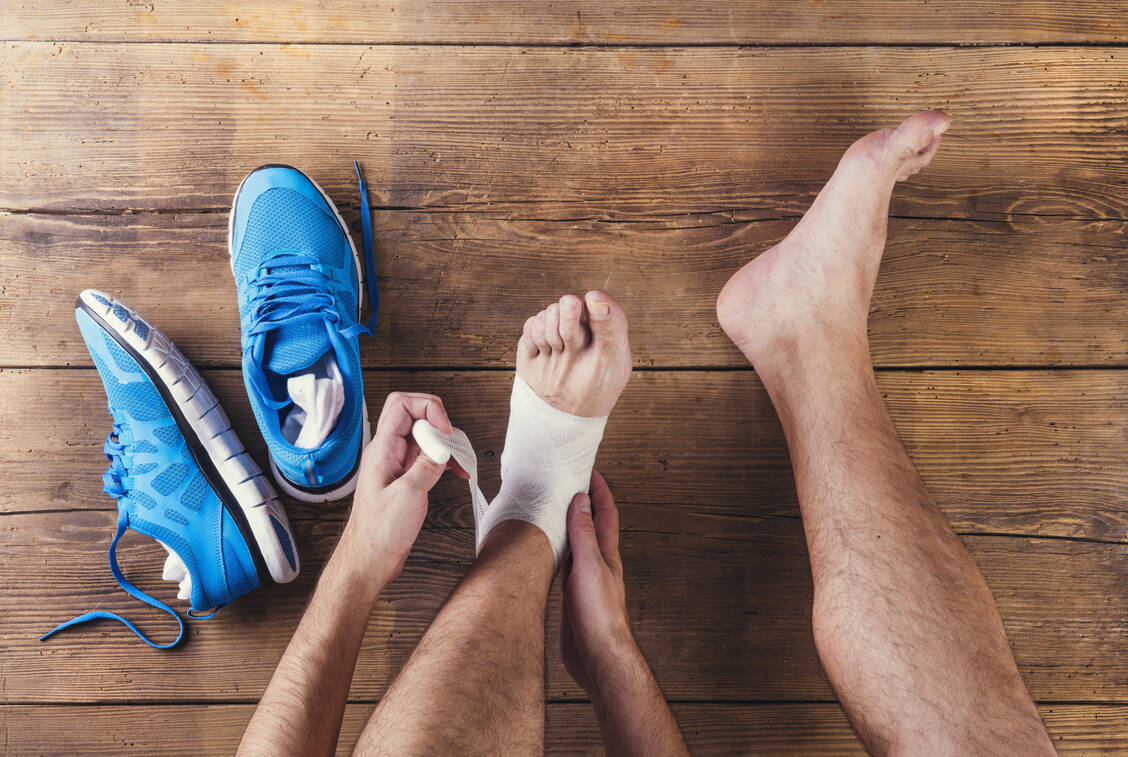
Weitere Angebote der PZ

© 2025 Avoxa - Mediengruppe Deutscher Apotheker GmbH
Taking the right measures |

When it comes to immediate measures for minor (sports) injuries without an open wound, many people immediately think of the PECH-rule: rest, ice, compression and elevation. / Foto: Adobe Stock/Halfpoint
Around 250 muscle fibres are combined by connective tissue to form a bundle of muscle fibres, the primary bundle. Several primary bundles together form larger, up to half a centimetre thick secondary muscle fibre bundles. Muscles can be overstretched or pulled as a result of sudden movements, excessive strain or incorrect warm-up. Muscle strains are tiny injuries within the muscle fibres. Typically, they occur in the superficial muscles that cross two joints, such as the hamstring muscles that run across the hip and knee joints. The main symptom is sudden pulling pain.
Muscle bruising can result when force, for example from impacts or blows, acts directly on the muscle. A painful haematoma develops in the muscles, which are heavily supplied with blood. A torn muscle fibre tears a muscle cell. The injury is more serious if a bundle of muscle fibres tears. If the muscle is completely severed, this is a muscle tear. Fortunately, however, this injury is rare. Depending on the severity, muscle injuries can put a patient out of action for days, weeks or even months. A quick and correct response can help to minimise the severity of the injury.
When it comes to immediate measures for minor (sports) injuries without an open wound, many people immediately think of the PECH-rule: rest, ice, compression and elevation. These four measures apply for the first 24 hours after an injury and are designed to reduce haemorrhaging and swelling. However, a key part of the PECH rule, namely cooling, is now controversial. If the body temperature is lowered locally, this causes vasoconstriction and reduced blood flow. Although this may make a haematoma less pronounced, it also reduces blood flow, which can be useful in this situation. It ensures that more nutrients and oxygen reach the affected tissue.
If cooling is used, it should therefore not be done for longer than five to ten minutes. It is sufficient to wet a towel with cold water at around 15°C and wrap it around the injured limb as a compress. If you prefer to use hot-cold compresses, never apply them directly to the skin, as there is a risk of tissue damage. Patients should always wrap frozen packs with a thick cloth.
Instant cold pads, such as the WEPA disposable instant cold compress, are suitable for travelling. The inner bag filled with water bursts when pressed. The water mixes with a cooling granulate. The dissolution of the granules is an endothermic reaction that removes heat from the environment. Cold sprays are an alternative for the sports bag. The pharmacy team can also point out that cold reduces the perception of pain. There is a risk that the injured body part will be stressed beyond its current capacity. The body may react to this by producing more scar tissue and tissue hardening.
There is general agreement that it is advisable to temporarily immobilise the injured limb immediately after an injury. Applying light pressure to the injured area (compression) should minimise and stabilise bleeding and swelling. Patients can apply (or have applied) an elasticated pressure bandage for this purpose. Elevation means that the affected part of the body is positioned higher than the heart. This improves the return flow of blood and any fluid that has escaped into the tissue can be removed more quickly.
After the acute phase, it has a positive effect on the healing process if the damaged part of the body does not remain inactive for too long. For this reason, patients should start with pain-adapted movement as soon as possible, paying attention to the signals from their body and not overdoing it.
PTA can offer various remedies to alleviate the symptoms and support healing. Non-steroidal anti-inflammatory drugs (NSAIDs) taken orally, such as ibuprofen or diclofenac, reliably relieve musculoskeletal pain. However, the systemic absorption of the active ingredients is associated with side effects, for example in the gastrointestinal tract. In the case of ambitious athletes, the pharmacy team can question whether they want to take the analgesics in order to continue training despite the injury. Pain is a warning signal from the body and should prompt the athlete not to aggravate the injury any further.
The combination of oral NSAIDs and high physical exertion also increases the risk of kidney damage and gastrointestinal bleeding. For many muscle injuries, the painkiller does not need to be taken orally and a local therapy can also achieve an effect. Ointments and gels containing diclofenac or ibuprofen are generally well tolerated. However, skin irritations such as dryness, contact dermatitis and itching can occur as a local side effect. Many patients find that massaging the gel into the skin is soothing and relaxing. Gels also score points for their immediate cooling effect.
| Deutsch/German | Englisch/English |
|---|---|
| Akutphase | acute phase |
| Aufwärmen | warm up |
| Bluterguss | haematoma |
| Blutung | bleeding, haemorrhage |
| Faserriss | fibre tear |
| Heilung | healing |
| Hüftgelenk | hip joint |
| Juckreiz | itching |
| Kniegelenk | knee joint |
| Kontaktfermatitis | contact dermatitis |
| Muskel | muscle |
| Muskelfaser | muscle fibre |
| Oberschenkel | thigh, femur |
| Prellung | bruise |
| Schwellung | swelling |
| Verletzung | injury |
| Wade | calf |
| Wunde | wound |
| Zerrung | strain, strained muscels |